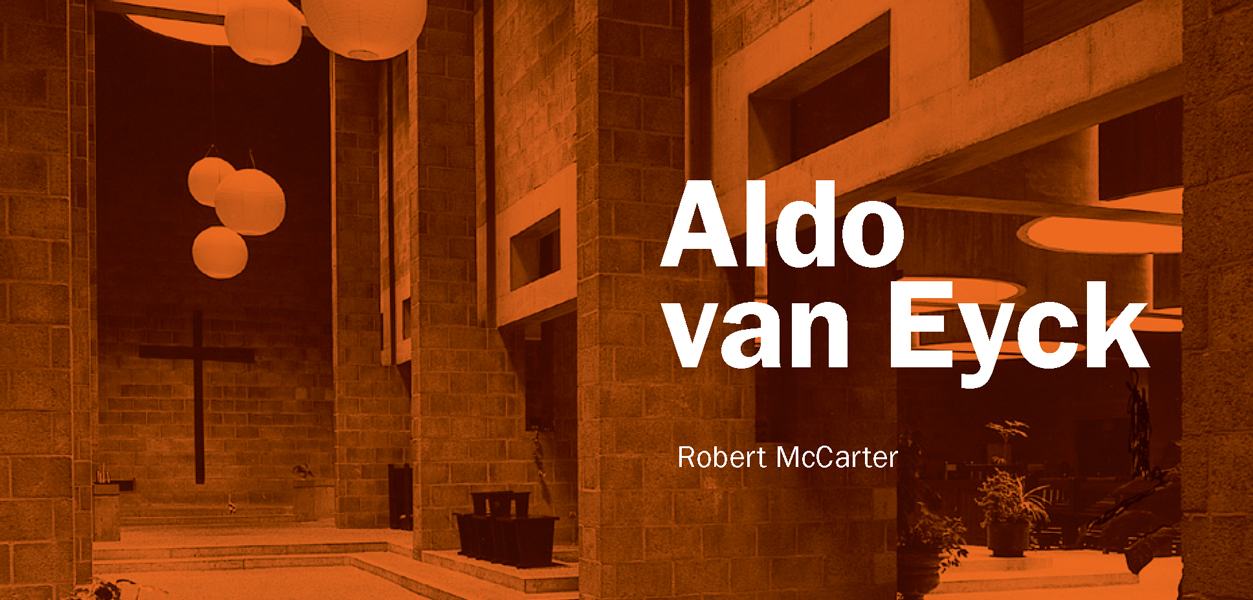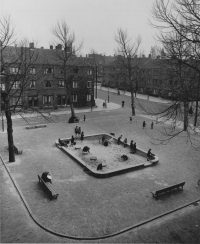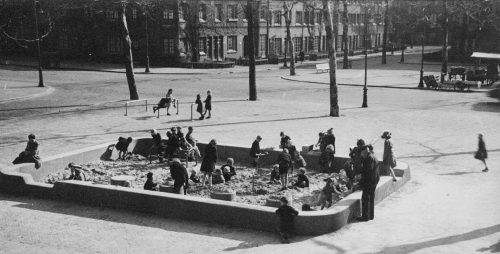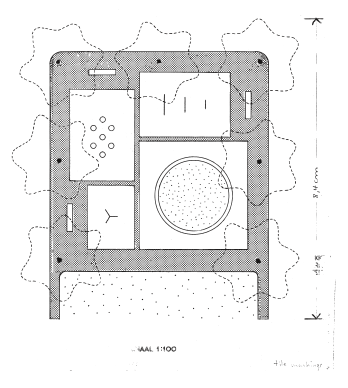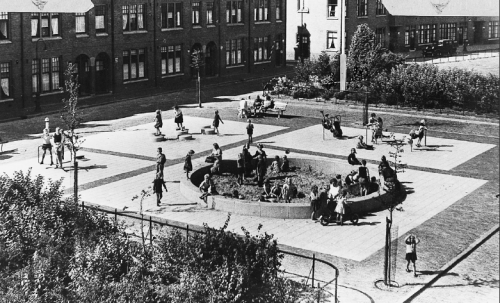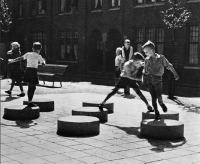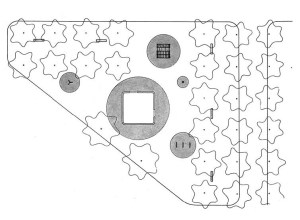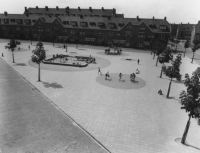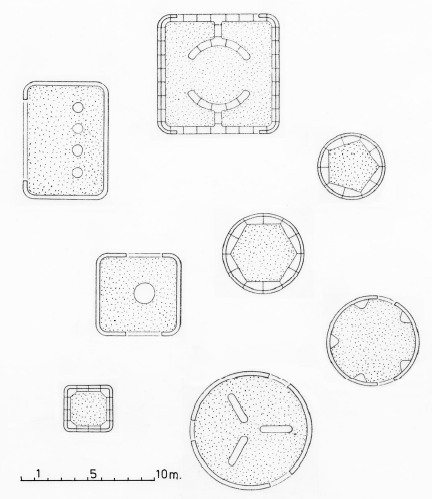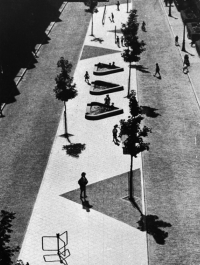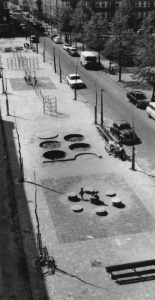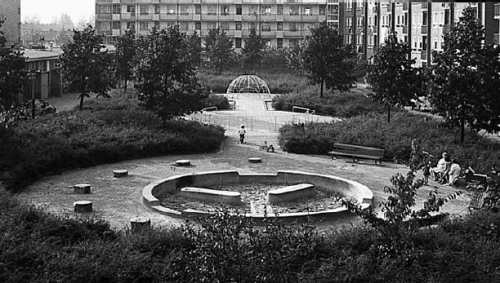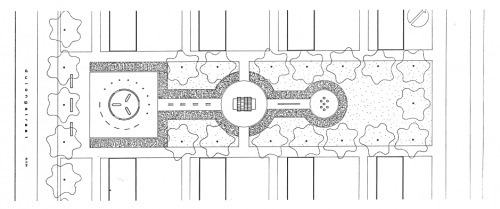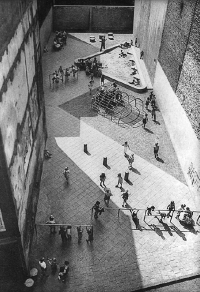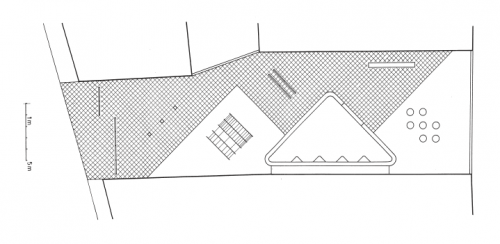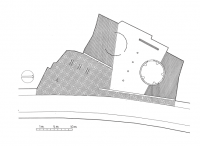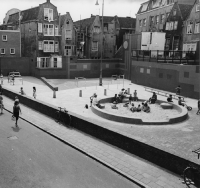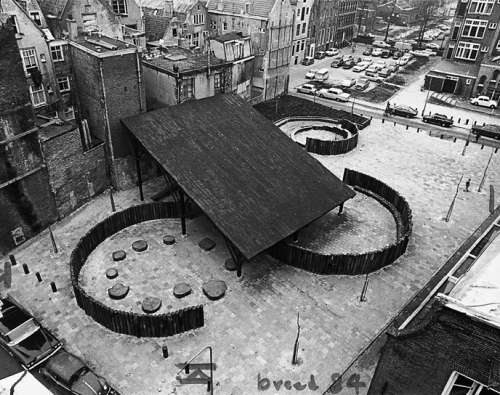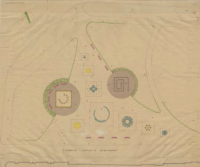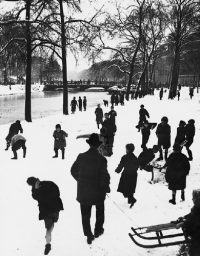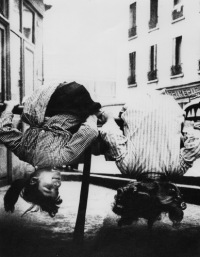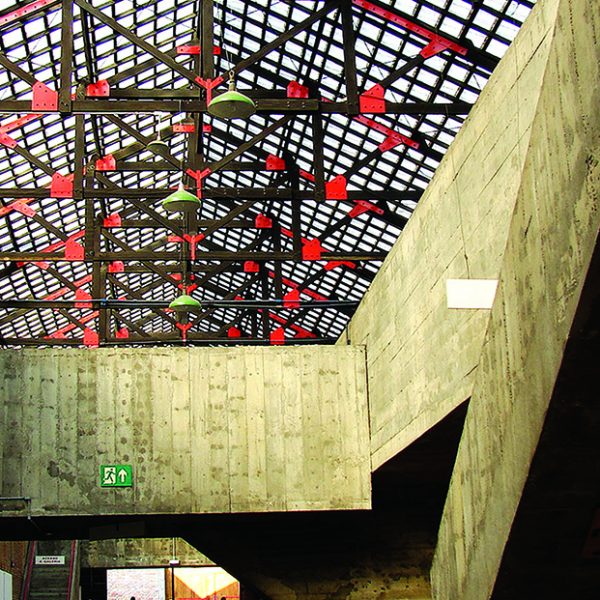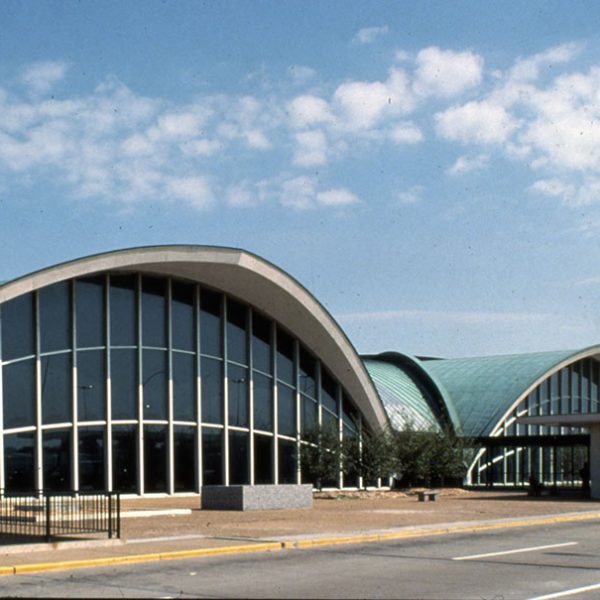Sneak peek: Aldo van Eyck
We’re looking forward to the publication, this spring, of a stellar new comprehensive assessment of the career of Dutch architect Aldo van Eyck, whose work, writing, and teaching all contributed significantly to redefining Modern architecture in the second half of the 20th century. The author of the book is Robert McCarter, Ruth and Norman Moore Professor of Architecture, Sam Fox School of Design & Visual Arts, Washington University in St. Louis.
Thinking about this book’s spring publication also reminds us that warmer weather is coming. In honor of spring and the ability to spend time outside free from layer upon layer of wool and goosedown, we’re sharing an excerpt from Aldo van Eyck today that deals with his numerous, and brilliant, playground designs.
When he first came to work in the town planning department in Amsterdam in 1946, 28-year old Aldo Van Eyck was initially assigned to work on aspects of the Amsterdam General Extension Plan, designed by the architect and urban planner Cornelius Van Eesteren in 1934. Yet Van Eyck found that he did not have much sympathy with the “Zeilenbau” planning model then being used by the town planning office, with its relentless parallel building configurations forming undefined and open-ended spaces between the housing slabs. While he admired Van Eesteren as one of the pioneers of De Stijl, which they often discussed at the end of the workday, Van Eyck found the department’s planning methods strangely dissociated from the principles of De Stijl, and he endeavored to devise alternative urban designs that would more precisely articulate bounded urban spaces. Eventually, sensing Van Eyck’s restlessness, Van Eesteren gave him the assignment to work on the design of new children’s playgrounds, part of a program initiated by Jakoba Mulder, head of town planning, to build one new public playground in every neighborhood of Amsterdam.
Beginning in 1947 and continuing for more than thirty years, Van Eyck would design over seven hundred playgrounds for children in the city of Amsterdam. These extraordinary site-specific designs, which included the development by Van Eyck of a wide range of permanently installed play equipment, were either shoehorned into vacant, abandoned, or war-damaged sites scattered throughout the old city center or placed in the interstitial spaces of housing developments at the city’s perimeter, often surrounded by active roadways; all the playgrounds were built on the most modest of budgets. Nevertheless, not only does each playground possess a distinctive sense of place, but as a group they show a remarkable relation to the work of modern artists, particularly De Stijl artist Sophie Taeuber-Arp. Works such as Taeuber-Arp’s Relief rectangulaire of 1936, with its wooden surface articulated with cubic and cylindrical patterns, holes, and projections, served as a source of continuous inspiration for Van Eyck in his design of the playgrounds. In these designs, Van Eyck engaged the flat landscape of Amsterdam as if the ground were a canvas, placing stepping-stones and carving sand pits as positive and negative circles and rectangles, the whole surface bound together with the simplest paving materials employed in careful patterns.
The first playground built to Van Eyck’s design was located on a small public square measuring 25 x 30 meters on the Bertelmanplein, in the northwest corner of Berlage’s Amsterdam South. Bounded on the east and south sides by larger streets, with a smaller L-shaped road wrapping the other two sides, the site had ten existing street trees and was surrounded by Amsterdam School housing designed by Johannes C. van Epen. Toward the northwest corner of the site, Van Eyck placed a large rectangular sandpit bounded by a low concrete wall, 30 cm tall and 30 cm wide, with curved corners and rounded edges and with lowered entries for the smallest children on the north and west sides, where the adjacent roads had little traffic (fig. 1). The concrete bounding wall of the sandpit was low enough with respect to the surrounding plaza paving to allow people to sit, as well as high enough with respect to the slightly lower sand bed inside to allow children to use it as a work surface. Inside the sandpit was a low, arched, steel climbing frame, and four cylindrical concrete elements, 65 cm in diameter, placed in a line along the north edge— appearing as islands in the sea of sand—which children used as both stepping-stones and tables. Toward the southeast corner, three steel U-shaped frames provided a place to turn somersaults and hang upside down, and five wooden benches were set around the outer perimeter of the brick-paved plaza.
The Bertelmanplein playground was a simple, minimal composition of a few elementary forms, yet the relationship between the elements and their precise positioning on the site created a remarkably strong sense of place. The sandpit, the primary destination for children, was not placed at the center of the plaza, but removed to the more quiet, traffic-free northwest corner, far from the street intersection. Three somersault frames were set closer to the intersection, where the children’s acrobatic stunts would be more visible to passersby, allowing the children to show off their skills (fig. 2). The openness of the entire space to the surrounding sidewalks and streets is striking, as is the absence of anything even remotely resembling a perimeter fence. The low, thick wall of the sandpit is the only enclosure on the site, and yet it effectively forms a smaller world within the larger world of the neighborhood—an interior place where a child feels at home. “But this sort of interior is hard to achieve with a fence,” Van Eyck stated. “A fence has the effect of keeping people away. Plants or walls are more suitable for making the playground a space of one’s own.” Van Eyck’s design for the Bertelmanplein playground proved to be so popular with local residents and the Amsterdam city council that the municipality initiated a building effort that would last until 1978, with more than sixty playgrounds built to Van Eyck’s designs in the next eight years alone.
The second Van Eyck–designed playground was built in 1948 in the courtyard of the large perimeter block housing structure named Zaanhof, built to the designs of Walencamp, Greve, Kuipers, and Ingwersen in 1917–19, in the Spaarndammer neighborhood of Amsterdam West. On this 20-meter-square site, surrounded by access roads on three sides, Van Eyck placed trees at the four corners and at the centers of each side, marking the center axes, but the rest of the design was asymmetrical and nonaxial. Four different play areas were positioned on rectangular sections paved with white concrete square tiles, which contrasted with the brown brick paving of the rest of the plaza and its surrounding sidewalks (fig. 3). In the center of the largest white-paved play area, square in shape, was a round sandpit, bounded by a low, wide wall. Diagonally across from the sandpit, a medium-sized rectangular play area housed at its center seven low concrete cylinders, set in an interlocking square pattern in plan, which served as stepping-stones for children. The other medium-sized rectangular play area had at its center three steel somersault frames, each a different size, and in the center of the smaller rectangular play area, diagonally across the playground, a triangular steel roundabout allowed children to ride in circles. Three wooden benches were placed in the three brick-paved corners of the square plaza, facing the three smaller play areas (fig. 4).
Each of the white-paved play areas at Zaanhof established its own center, and yet the overall composition of the playground was asymmetrical, opening outward toward the neighborhood in all directions. The benches at the periphery subtly but effectively removed the adults from the centers of play activity, making it clear that they belonged to the children. Children naturally clustered at the play destinations at the center of each white-paved area, and the brown brick bands separating them served as informal boundaries, allowing the children to recognize when they were entering a different play space. Period photographs show children jumping from one cylindrical stone to the other, chasing each other in a series of diagonal leaps, without ever letting their feet touch the paved plaza (fig. 5). In the joy on the faces of these children at play, one senses the way in which Van Eyck’s design engaged his deep understanding of childhood, his profound empathy and respect for children, and his sensitive articulation of the experience of being a child in the city.
The third playground built to Van Eyck’s designs, in 1949, was on Jacob Thijsseplein, on one half of a wide, triangular plaza framed by three-story housing all around and split in two at its center by a street. The north half of this plaza was planted as a public park, and Van Eyck was asked to design the playground on the larger, 2,000-square-meter paved southern half of the plaza, using a limited number of elements. Van Eyck shaped the space of the large open plaza by planting a double row of six chestnut trees each along the central dividing street, which was matched by a row on the other side of the street; a second double row of four trees each along the west edge of the site, reaching to the narrow point of the triangle; and two trees along the diagonal street edge to the east. Wooden benches were placed in the shaded areas between the trees, from which parents could look out into the central play area (fig. 6).
In the white concrete tile paving of the plaza at Jacob Thijsseplein, Van Eyck made five red brick–paved circles of different sizes, all but the largest positioned so that their centers aligned with the spaces between the trunks of the three rows of trees to the north. The square sandpit was located in the largest brick circle, and its off-center opening was aligned with the space between the trees to the north. In order of diminishing size, the brick circles held the large steel climbing arch (provided with an unpaved area beneath, for softer landings in case of falls), three equal-sized somersault frames, a triangular roundabout, and a drinking fountain (fig. 7). The playground’s subtle, asymmetrical axial order is not readily discernable by examining either the floor plan or period photographs taken from the upper floors of the buildings across the street. It can only be perceived in the experience of occupying the playground, sitting on the wooden benches in the shade of the trees, where, as we watch children at play in the central open space, we slowly become aware that the benches and the circular brick play areas are centered on the same axes.
When examined as a group, what is perhaps most striking about Van Eyck’s playgrounds is that each one is an entirely unique design for a specific site; each one turns often seemingly irresolvable existing conditions to advantage; each one uses the same limited set of common elements; each one is clearly a part of a family of forms—and yet the particular arrangement of each design is never repeated. Even when several sites seemed to present very similar challenges and restrictions, Van Eyck always developed a specific solution for each. This was enhanced by the archetypal forms Van Eyck gave to the play elements: the sandpits in square, rectangular, circular, and hexagonal shapes; the steel tube climbing elements in arched, domed, and conical shapes, which, depending on whether one was above or beneath them, could be either exposing a hill or enclosing a house; the steel somersault frames that could stand in serial sets or join together to create weblike enclosing walls; and the stepping or jumping stones of varying heights and shapes, circular, square, and hexagonal (fig. 8).
A number of the playgrounds were designed for central median strips set between lanes of divided roadways, and the diversity of Van Eyck’s designs for this similar situation is remarkable. The playground on Saffierstraat, built in 1950, was sited on a 120-meter-long but only 6-meter-wide median strip, which was paved in white concrete tiles set on a diagonal pattern, with five triangular sections of brown brick paving inserted on alternating sides. Eight trees were planted toward the outer edge of the raised playground strip, alternating from one side to the other (fig. 9). Three triangular sandpits were positioned off-center in the long space, with three sets of steel climbing rails, a triangular roundabout, and a long wooden bench spaced out to either side. The extended length of the playground was effectively divided into smaller spaces by the contrasting diagonal paving patterns and insertions of play elements. In the playground Van Eyck built in 1965 on a broad median strip on Sumatraplantsoen in Amsterdam West, a repeating pattern of circular sandpits was carved into slightly elevated square planes, with a solid circular disk projecting at one end, and a half-circle carved out of the other (fig. 10). Combined with the circle of cylindrical jumping stones of varying height—a kind of child’s Stonehenge—the design comes closer to Taeuber-Arp’s Relief rectangulaire of 1936 than any of the other playgrounds.
In contrast to these narrow median locations, at the playground at Mendes da Costahof of 1957, located in a wide park space surrounded by streets on all sides, Van Eyck employed dense, low plantings to shape and enclose three circular spaces connected by a central axial connecting passage (fig. 11). The first space contained a large circular sandpit, with three thick concrete bench-tables placed within it in a radial pattern, and the sandpit was surrounded by a brick-paved plaza, into which were set wooden benches on one side, and on the other a series of cylindrical stepping-stones, rising incrementally from low to high. In the central circular space, three curving somersault frames interlocked to enclose the space, and in the third, smallest circular space stood a large steel climbing dome. The dense plantings at the periphery of this and similar playground sites combined with the introverted circular spaces to create a sense in the inhabitants that the playground was a world apart, a magical space (fig. 12).
Perhaps the most challenging playground designs were those for the residual spaces between buildings, and here the “before” and “after” photographs of Van Eyck’s designs are simply astonishing. The playground at Dijkstraat, built in 1954, was located in the 25-meter-long, 10-meter-wide site of a house that had been demolished during the war, between three- and four-story buildings in the center of Amsterdam.
[bs_row class=”row”]
[bs_col class=”col-sm-6″]
[/bs_col]
[bs_col class=”col-sm-6″]
[/bs_col]
[/bs_row]
It opened to the street only at one narrow end, with a wall closing off the other narrow end (fig. 13). A large triangular sandpit anchored the far end of the playground, and the ground was paved with white concrete tiles and brown bricks, which were set on the diagonal to form two larger interlocking volumes and a series of smaller triangular play spaces (fig. 14). Two long somersault frames overlapped to form a portal, acting to subtly define entry from the street. In the first triangular, white-paved space were three tall concrete cylinders for vaulting over, set in a diagonal line; a large steel climbing arch was placed in the brick-paved, second triangular space; the sandpit intruded into the third triangular, white-paved space, dividing it in two, with a set of parallel gymnastic bars in the near space and a long wooden bench in the farther space; and finally, at the back of the playground, in the fourth triangular, brick-paved space, were seven cylindrical jumping stones of varying heights. Despite their only existing on the ground plane, the modest, minimal elements of Van Eyck’s design charged this enclosed space with remarkable dynamic energy.
[bs_row class=”row”]
[bs_col class=”col-sm-4″]
[/bs_col]
[bs_col class=”col-sm-4″]
[/bs_col]
[bs_col class=”col-sm-4″]
[/bs_col]
[/bs_row]
The playground on Zeedijk in the Nieuwmarkt area of central Amsterdam, built in 1956, was sited on an irregularly shaped vacant lot, surrounded on three sides by solid side and rear walls of adjacent buildings that varied dramatically in height (fig. 15). In this unique case, Van Eyck realized that he could not solve the problem of making a place using only architectural means, and he called upon his friend and brother-in-law, painter Joost van Roojen, to collaborate with him on the playground design. Removing a high wall that had previously closed the site off from the street, Van Eyck placed a low, 60-cm-high brick wall that extended halfway across the opening to the street, aligning with the street front of the taller adjacent building to the north. He placed a second, 30-cm-high brick wall at an angle to the first wall, parallel to the rear wall of the playground and connecting to the building corner protruding into the south side of the site. The large gray paving stones of the sidewalk were brought into the site to meet the second wall, and three pairs of somersault frames and a turnabout were placed in this outer space. Where the two low walls overlap, one entered the more interior section of the playground, the central portion of which was paved in white concrete tiles, flanked on either side by smaller spaces paved with brown brick (fig. 16). Overlapping between the white concrete pavers and the brick pavers on the north side was a large circular sandpit, into which five triangular seat-tables were projected, while on the south side the joint between the concrete and brick pavers was overlapped by a three-quarter circle made of steel somersault frames of varying height. Set between the two circular play areas, in the center of the white concrete pavers, were four concrete vaulting cylinders set in a line. Van Eyck’s plan is a balanced composition of highly irregular surfaces and spaces, together forming a unified and articulated place out of the chaotic and fragmented site. Two years later, Van Roojen painted the walls that bounded Van Eyck’s dynamic ground composition with rectangles, lines, and circles in various shades of green, blue, orange, brown, gray, and yellow (fig. 17). Similar to the Blue-Purple Room of four years earlier, Van Eyck believed this was “a space organized purely by means of color.”
Van Eyck believed that the design of playgrounds was an essential architectural task, and that the child was the most important inhabitant of the city: “If we create a playground well, we create a world in which man rediscovers what is essential, in which the city rediscovers the child.” The only book he ever wrote, intended as a summation of his discoveries as to the nature of architecture, was titled, significantly enough, The Child, the City and the Artist. In his writings, Van Eyck celebrated those rare times, such as after a heavy snowfall, when the children take over the spaces of the city, and the entire city becomes a playground. For its children, he argued that the city needs “something more permanent than snow,” and he saw the playgrounds as places where the child can be “Lord of the city” all the time. He believed that the transformation of the city into a place for children was an ethical imperative for society: “If childhood is a journey, let us see to it that the child does not travel by night.” In making his designs, Van Eyck drew on his collection of photographs of children at play in Venice, Amsterdam, London, and other cities around the world, for he understood that children find ways to play with everything built in the city, whether they were intended as children’s playthings or not (figs. 18–21). In his playground designs, each a site-specific accommodation of everyday life, he combined classical axial, symmetrical, geometric forms with modern, De Stijl–inspired asymmetrical, polycentric organization, and it was in the playgrounds, his earliest works, that Van Eyck developed many of his most essential insights into architecture and urban form.
[bs_row class=”row”]
[bs_col class=”col-sm-4″]
[/bs_col]
[bs_col class=”col-sm-4″]
[/bs_col]
[bs_col class=”col-sm-4″]
[/bs_col]
[/bs_row]























